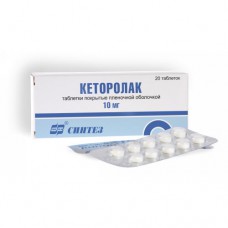Expiration date: 08/2026
Tablets:
Action:
analgesic, effect, antipyretic, anti-inflammatory
Composition:
Ketorolac 10mg
Auxiliary substances: milk sugar, starch kartofeliny, magnesium stearate, talc, kollidon,
Indications:
for short-term relief of moderate to severe pain of various origins
Synonyms:
Ketanov, Dolomin, Dolac, Katelyn
Ampoules:
International non-proprietary name: Ketorolac tromethamine (Ketorolac Tromethamine).
Dosage form: solution for intramuscular introduction
Composition
Ketorolac 30 mg trometamina
Excipients: alcohol 0.121 ml, sodium chloride 4.35 mg disodium EDTA 1.0 mg octoxynol 0.07 mg, sodium hydroxide 0.725 mg propylene glycol 400 mg water for injections to 1 ml
Pharmacotherapeutic group: nonsteroidal anti-inflammatory drugs
ATC code: M01 AB15
Pharmacological properties
PHARMACODYNAMICS: Ketorolac, as non-steroidal anti-inflammatory drug that has analgesic, antipyretic and anti-inflammatory effect. Mechanism of action at the biochemical level, the inhibition of the enzyme cyclooxygenase, mostly in peripheral tissues, resulting in the inhibition of the biosynthesis of prostaglandins - modulators of pain sensitivity, thermoregulation and inflammation. Ketorolac is a racemic mixture of [-]S and [+)R enantiomers, with the analgesic action is due to [-]S form. The drug does not affect opioid receptors, not oppressing breathing, does not inhibit intestinal motility, does not possess sedative and anxiolytic effect, does not cause drug dependence. Ketorolac inhibits platelet aggregation and increases bleeding time. The functional state of the platelets recovers in 24-48 hours after discontinuation of the drug.
PHARMACOKINETICS: the Bioavailability of Ketorolac after intramuscular injection ranges from 80% to 100%. The pharmacokinetics of Ketorolac in terms of destination average therapeutic parenteral doses is a linear function. The equilibrium concentration of the drug in plasma by 50% exceeds the same indicator determined after a single injection. More than 99% of drug binds with plasma proteins of blood, resulting in the apparent volume of distribution is less than 0.3 l/kg.
Ketorolac is metabolized mainly with the formation of conjugated forms of glucuronic acid which are excreted via the kidneys. Metabolites have analgesic activity. The half-life of the drug is 5 hours on average.
Indications for use:
A short treatment of the pain syndrome of moderate to severe intensity, mainly after traumas, in the postoperative period when radicular syndrome, muscle pain.
The dosage and method of application:
Ketorolac should be used once or repeatedly with a fixed reception frequency for the relief of significant pain syndrome (including postoperative period), requiring the use of opioids. The duration of use of Ketorolac should not exceed 5 days for parenteral administration. The solution is slowly injected intramuscularly (deep into muscle). The analgesic effect starts to develop after 30 minutes and the maximum effect is reached after 1-2 hours. Duration of action is usually 4-6 hours.
For a single application is assigned:
- patients up to 65 years of age - 60 mg,
- patients older than 65 years, patients with renal impairment, or weight less than 50 kg - 30 mg
For multiple applications assigned:
- patients up to 65 years of age - 30 mg every 6 hours maximum daily dose should not exceed 120 mg
- patients older than 65 years, patients with renal impairment, or weight less than 50 kg - 15 mg every 6 hours maximum daily dose should not exceed 60 mg
Side effect:
Most often have gastrointestinal disorders, among whom more than 10% of patients, nausea, pain in the stomach and intestines, dyspepsia, often, diarrhea (7%). From the Central nervous system characterized by disorders such as headache (17%), drowsiness (6%), dizziness (7%). In 4% of cases develop swelling.
Somewhat less, but more than 1% of patients develop hypertension, pruritus, rash, stomatitis, vomiting, constipation, flatulence, feeling of heaviness in the abdomen, sweating, and hemorrhagic rash. Less than 1% of patients can weight loss, fever, asthenia, palpitations, pallor, fainting, skin rash, gastritis, bleeding from the rectum, loss of or increased appetite, belching, nosebleeds, anemia, eosinophilia, tremor, sleep disturbances, hallucinations, euphoria, extrapyramidal syndrome, paresthesia, depression, nervousness, thirst, dry mouth, blurred vision, worsening attention span, hyperkinesis, stupor, shortness of breath, pulmonary edema, rhinitis, cough, hematuria, proteinuria, oliguria, urinary retention, polyuria, frequent urination.
Cases of hypersensitivity reactions (anaphylaxis, anaphylactoid reactions, laryngeal edema, tongue edema), hypotension and flushing to the skin, Lyell's syndrome, Stevens-Johnson syndrome, exfoliative dermatitis, macula- papular rash, urticaria, the formation of ulcers in the mucous membrane of the stomach, gastrointestinal bleeding, perforation of the walls of the gastrointestinal tract, melena, acute pancreatitis, postoperative wound hemorrhage, thrombocytopenia, leukopenia, hepatitis, hepatic failure, cholestatic jaundice, convulsions, psychosis, aseptic meningitis, bronchospasm, acute renal failure, pain, and the kidneys, hematuria, and azotemia, hyponatremia, hyperkalemia, hemolytic uremic syndrome.
To prevent possible side effects, you should strive to use the minimum effective dose of the drug accurately follow the specified dosage and modes of administration, to take into account the condition of the patient (age, renal function, gastrointestinal tract, water-electrolyte metabolism and hemostatic system), and possible drug interaction in combination therapy.
Contraindications:
Bronchial asthma, Complete or partial syndrome of nasal polyps, bronchospasm, angioedema in history.
Ulcers disease stomach and duodenal ulcer in acute, as well as a history of ulcers or gastrointestinal bleeding, the presence or suspicion of gastrointestinal or intracranial bleeding.
A blood clotting disorder, a history of the condition with a high risk of bleeding, hemorrhagic diathesis, coagulopathy, hemorrhagic stroke, treatment with heparin in low doses. Surgical intervention with high risk of bleeding or risk of incomplete it stops.
Moderate and severe renal failure (plasma creatinine above 50 mg/l), the risk of renal failure, hypovolemia, dehydration.
Pregnancy, delivery period and breastfeeding.
Hypersensitivity to Ketorolac, aspirin, other NSAIDs or any component of the drug.
Concurrent intake of other NSAIDs (risk summation side effects)
The age of 16
Congestive heart failure
The drug is not used for anesthesia before and during surgical operations.
Ketorolac is not used for epidural and intrathecal injections.
Application features
The appointment of patients with impaired liver function: assigned with caution. While taking Ketorolac may increase the level of liver enzymes. In the presence of functional abnormalities in the liver in patients receiving Ketorolac may develop more severe pathology. The detection of signs of disease of the liver treatment should be discontinued.
Patients with renal insufficiency or diseases of kidneys in anamnesis: Ketorolac is assigned with caution.
The appointment of older patients: because patients in this age group are more likely to develop adverse reactions, you should use the minimum effective dose (therapeutic daily dose of not more than 60 mg for patients older than 65 years).
Pregnancy and lactation: efficacy and safety not established.
Food reduces the rate but does not affect the amount of absorption of Ketorolac.
The effect on performance of laboratory research: may increase bleeding time in the study of indicators of coagulation.
Since a significant portion of patients in the appointment of Ketorolac develop side effects from the Central nervous system (drowsiness, dizziness, headache) it is recommended to avoid jobs that require attention and fast reaction.
Warnings and precautions
Before administration of Ketorolac should correct hypovolemia and hypoproteinemia, and to restore fluid and electrolyte balance.
The delay in the body fluid, sodium chloride, oliguria, increasing the concentration of urea nitrogen and plasma creatinine were observed in clinical trials, and therefore should be used with caution in Ketorolac to patients with heart failure, hypertension or pathological conditions with similar manifestations.
Because Ketorolac affects platelet aggregation, use in patients with pathology of blood coagulation system must be carefully monitored. Extreme caution shall be appointed Ketorolac in combination with anticoagulants.
Drug interaction
Ketorolac reduces slightly the degree of protein binding of warfarin.
In vitro studies showed the influence of therapeutic doses of salicylates on the degree of binding of Ketorolac from plasma proteins to the downside from 99.2% to 97.5%.
When combined with furosemide may decrease the diuretic action of approximately 20%.
Probenecid decreases plasma clearance and volume of distribution of Ketorolac, increases its concentration in blood plasma and increases the period of its half-life. On the background of the use of Ketorolac may decrease clearance of methotrexate and lithium and increased toxicity of these substances.
Noted a possible interaction between Ketorolac and non-depolarizing muscle relaxants that lead to the development of apnea.
It is not excluded that the simultaneous use of ACE inhibitors may increase the risk of renal dysfunction.
Described rare cases of seizures when combining Ketorolac with anticonvulsants (phenytoin, carbamazepine).
You may experience hallucinations on the background of concomitant use of Ketorolac and psychoactive drugs (fluoxetine, thiothixene, alprazolam).
Overdose:
An overdose of Ketorolac after a single or repeated application is usually manifested by pain in the abdomen, the appearance of peptic ulcer of the stomach or erosive gastritis, violation of the kidney, hyperventilation, metabolic acidosis, these symptoms are cured after discontinuation of the drug. In these cases, gastric lavage, introduction of adsorbents (activated carbon) and symptomatic therapy. Ketorolac is not excreted sufficiently by dialysis.
Storage conditions: At temperatures up to 25ºC.
Packaging: Solution in ampoules of 1 ml, containing 30 mg of Ketorolac trometamina, in a package of 10 vials.
Shelf life: 3 years



